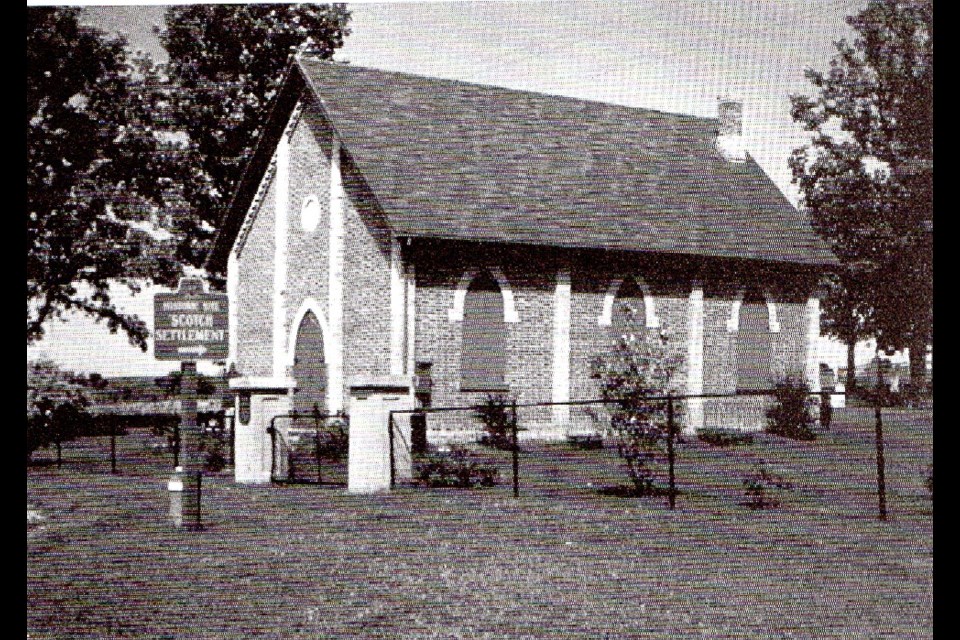Many new residents to Bradford may, while travelling along Highway 88 west to Highway 400, see a historical mention of the Auld Kirk with arrows to turn south.
If they have never checked it out, now is the time. Head south one mile to the Sixth Concession and turn right. You will see a lovely church on the north side of the road. The first church was a log building erected in 1823 where Presbyterians held their services.
Previous to the building of the log church, history tells us that a group of Highland Scots from Lord Selkirk's Red River settlement, disheartened by crop failures and the opposition of the North West Company, moved to Upper Canada. Transported in the North Western canoes, they disembarked at Holland Landing in September. Here they found temporary employment in the Yonge Street settlements, but in 1819 many took up land in West Gwillimbury.
The log church I spoke of earlier was replaced in 1827. The present brick structure was completed in 1869.
Many times as I look at the structure, I think of the long, hazardous and dangerous journey of the sturdy pioneers, of the difficulties and obstacles they encountered and overcame, on a 1,000-mile trip. No one can imagine their suffering and deliverance from perils of land and water. Having arrived at this spot, they needed to look for housing. And I don't mean looking for a comfortable 5,000-square-foot building; they grabbed a saw and hewed homes, usually one room with an attic for the boys, out of the wilderness. Then the next job on the agenda was to get some land tilled for root vegetables to be grown so they had food for the hard, cold winters.
Once they had a safe roof over their heads they erected the church on an acre of land which became the final resting place of the early settlers.
In winter months, the first church was used as a school. The first teacher was Mr. Moffatt in 1823. John Carruthers was the second teacher starting in 1826. The teachers were paid directly by parents until the School Act of 1841.
The Auld Kirk was the first settlers' church and the first school in Simcoe County. It was also the first Presbyterian church north of Richmond Hill.
The congregation was organized by James Harris of York (Toronto) on Jan. 6, 1822. James Sutherland was authorized by the Church of Scotland to conduct baptisms and marriages until there was a settled minister. Services were held four times a year by Rev. Wm. Jenkins, who made the trip on horseback from Richmond Hill. The first trustees were Messrs. Andrew MacBeth, Robert Sutherland and James McKay. On Jan. 24, 1824, there were 14 members. Adam Goodfellow, Alex Bannerman (forefathers of my relatives) and John Matheson were the first elders. In 1831, Rev. Peter Ferguson became the first pastor.
Unfortunately. the Auld Kirk was destined never to reach ambitious parochial heights, as one by one, other churches were built. In 1832, it was decided to send for a minister to establish Church of Scotland, with the result being that a new church was formed at Bond Head.
The Auld Kirk carried on until 1844 when the congregation was again divided. In 1871, there were so few still loyal to the little church that Presbyterian services were discontinued on a regular basis. Occasional services were held, but the church was finally closed in 1885.
Interestingly, the church never had an organ but a precentor with a tuning fork! Mr. George McKay was the last precentor, who carried on until the church closed. The services were in Gaelic and interpreted by John Matheson, who conducted Sabbath School.
The church was very badly in need of repair and the cemetery was over grown with brush when a restoration project started in the mid-1950s. In 1957, John Diefenbaker (former Canadian prime minister) visited the Auld Kirk as his grandparent and great-grandparent Bannermans are buried there.
Restoration is an ongoing thing for the little church and a title search realized that the church was actually owned by the United Church of Canada and was sold to the Town of Bradford West Gwillimbury. The church has had extensive restoration done to the building by the town along with the local historical society.
We talk about all the newcomers to Canada, but in actual fact if you stop and think of it, we are almost all newcomers to Canada starting many, many years ago.
If you ever have a spare moment, head down the Sixth and wander in the graveyard. There are many stones being repaired now, but as a young boy I used to walk back through our farm and the Elmer Kneeshaw farm and read the verses on the stones. One has always stuck in my mind:
“Reader reflect as you walk by
As you are now so once was I
As I am now so you will be
So prepare your self for eternity”
The historical society would be happy, I am sure, to receive donations to keep the restoration of the Auld Kirk progressing so it will be around for another 100 years.



